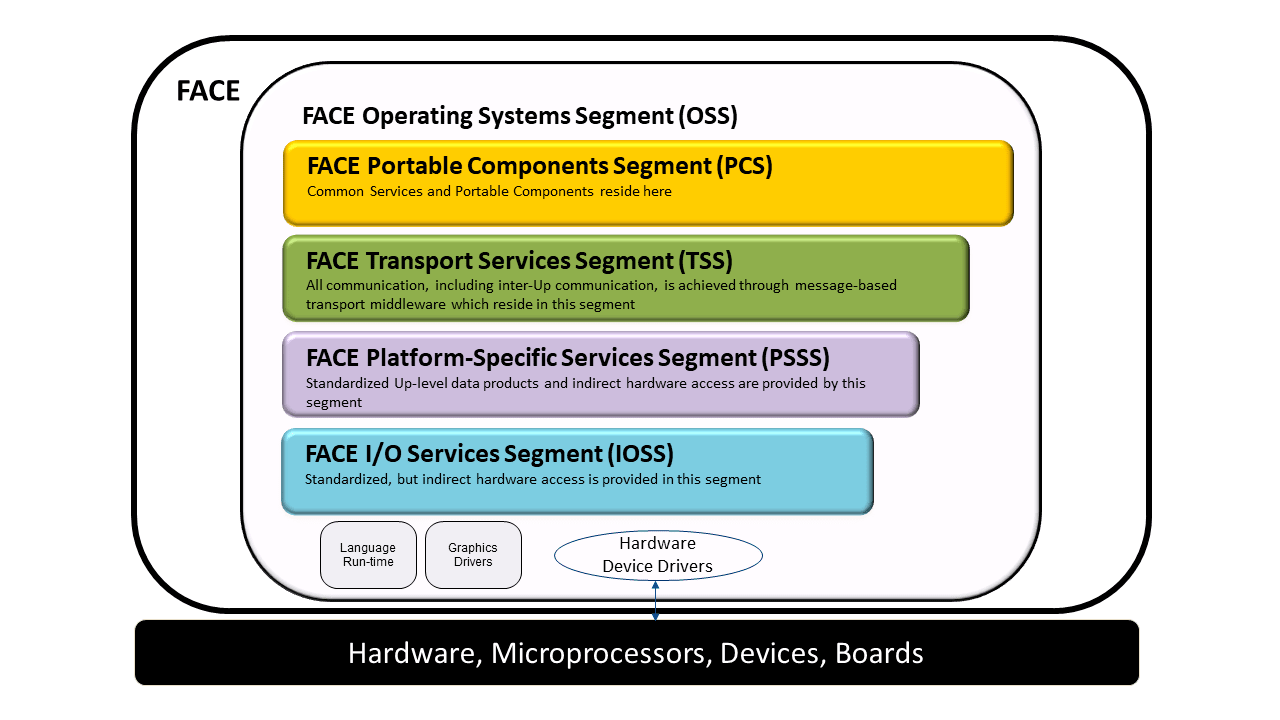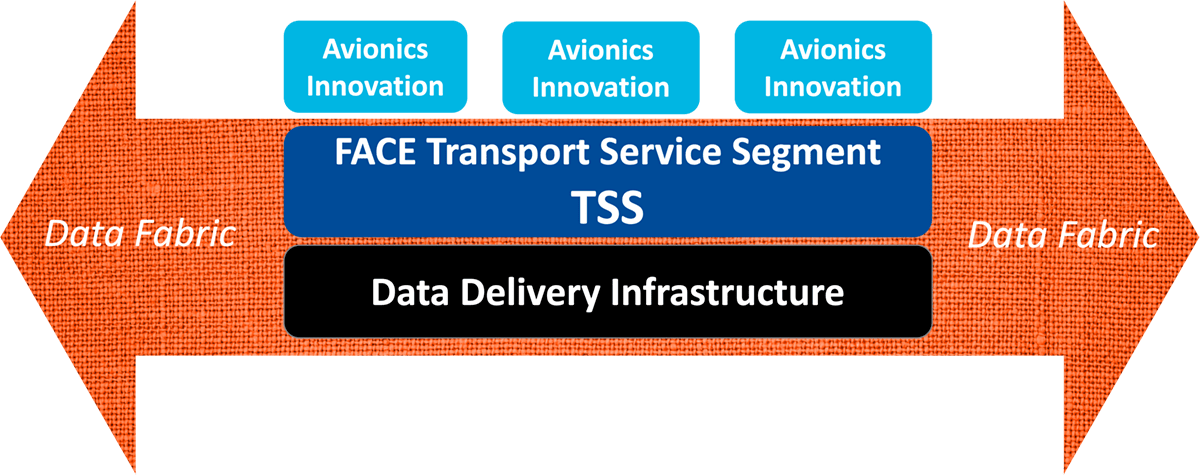3 min read
The FACE Transport Services Segment (TSS): Where Data Blossoms
 Chip Downing
:
August 23, 2022
Chip Downing
:
August 23, 2022

Part 4 of the RTI Military Avionics Blog Series
In previous blog posts in this series, I have discussed the powerful avionics industry standards that drive size, weight and power (SWaP) efficiencies in digital avionics systems. In addition, I discussed the use of the proven RTCA DO-178C safety standard that accelerates the safety certification of military and commercial avionics systems. I have also introduced The Open Group Future Airborne Capability Environment™ (FACE) Technical Standard and Business Approach that drives modularity, portability and interoperability in next-generation military avionics programs, and how this standard can leverage the RTCA DO-297 standard, “Integrated Modular Avionics (IMA) Development Guidance and Certification Considerations,” that defines three supplier roles that contribute hardware and software on a shared ARINC 653 compute platform.
This blog post is focused on the most powerful FACE segment, the FACE Transport Services Segment (TSS). But first, a quick FACE (re)introduction. The FACE Technical Standard is based upon a layered architecture designed for rapidly replacing any software component as required. These layers, or FACE segments, consist of a software component or domain-specific data model designed to meet the applicable requirements defined in the FACE Technical Standard for a defined FACE architectural segment. These software modules are referenced as a FACE Unit of Conformance (UoC) and can be certified FACE conformant using the FACE certification process that tests that the segment APIs exactly match the FACE Technical Standard through independent FACE Verification Authorities (VA).
The FACE Reference Architecture defines a set of standardized interfaces that provide connections between the five FACE architectural segments, as shown in Figure 1.

Figure 1. The Five Segments of the FACE Reference Architecture
FACE and Data Centricity
Data centricity is a property of a system architecture where data is the primary and permanent asset, and applications come and go. Instead of exchanging messages, software components share a common data model that unambiguously describes data topics and communicates via shared data objects that appear to applications to be local data. Applications directly read and write the value of these objects, which are cached in each participant.
When the FACE Consortium members created the FACE Technical Standard, data-centricity was designed into the standard for the delivery of well-defined, unambiguous real-time data to and from FACE PCSs.
Data-centricity enables the future. Due to the extremely high data integration rates required by autonomous systems, most of these designs have a data-centric architecture to allow for real-time integration of a vast array of sensor components to feed data into Artificial Intelligence and Machine Learning systems for instantaneous decision-making and control.
The U.S. Department of Defense (DoD) is rapidly transitioning to a data-centric enterprise. Data-centricity enables decision dominance at the speed of war and supports DoD efforts such as Joint All-Domain Command and Control (JADC2) that integrates sensors to command and control (C2) to effector systems across different operational commands, from the tactical edge to the cloud. This aligns exactly with the DoD Data Strategy announced in September 2020 that directs DoD leaders to evolve all DoD assets into data-centric assets that treat data as a weapon system.
The FACE Transport Services Segment (TSS)
The FACE TSS harnesses the power of data-centricity. Traditional avionics systems merely support the flow of bits out of ARINC 653 ports or simple messages from POSIX sockets, and provide this information for relatively simple piloted aircraft operations.
To enable the data-centric future, the FACE TSS integrates the flow of data from the FACE OSS, IOSS, and PSSS, and provides a rich, unambiguous and consistent representation of this data to PCS applications.
The FACE TSS is where autonomy comes to life by driving mission intelligence throughout the data fabric of advanced airborne platforms. The FACE TSS is where the capabilities of control and mission systems expand and blossom to deliver powerful solutions that arm Warfighters to compete with adversaries.
RTI Connext® TSS Empowers FACE Solutions
RTI leads the world in delivering commercial FACE TSS products. RTI has supported both the business and technical aspects of the FACE Consortium since its inception in 2010 and has continued this leadership with the Sensor Open Systems Architecture (SOSA™) Consortium.
RTI released the first certified conformant FACE TSS supporting the FACE Technical Standard, Edition 2.1, in 2018. Continuing this leadership position, RTI has just released the first certified conformant FACE TSS Edition 3.1 in August 2022. Both RTI Connext TSS implementations are based upon the open Data Distribution Service (DDS™) standard -- now used in thousands of defense platforms – which immediately enables vast connectivity across an array of devices and systems. Connext TSS also includes the open Real-Time Publish-Subscribe (RTPS) wire protocol that enables rapid interoperability between networked peers, reducing integration demands and accelerating time to deployment for competitive avionics capabilities.
Further extending its leadership, RTI Connext TSS now delivers commercial RTCA DO-178C DAL A certification evidence for both Connext Cert and Connext TSS that significantly reduces airworthiness certification efforts and further accelerates time to deployment.
 Figure 2 - The FACE TSS
Figure 2 - The FACE TSS
Conclusion
The FACE TSS is where data blossoms. It drives immediate modernization to legacy platforms. It is the innovation foundation of future aircraft systems, delivering consistent, unambiguous real-time data and mission intelligence throughout the system data fabric. Furthermore, the FACE TSS provides the data-centric architecture needed for JADC2 airborne platforms throughout the sensor-command-effector decision chain, compresses the Observe, Orient, Decide, Act (OODA) loop, and enables real-time responses to adversarial threats. It has the power to transform modern military aviation and support systems.
RTI Connext TSS is the world’s leading FACE TSS solution and is ready to help you build the future of tomorrow’s airborne systems today. Learn more about Connext TSS here.
About the author
 Chip Downing is Senior Market Development Director, Aerospace & Defense, Real-Time Innovations, Inc.
Chip Downing is Senior Market Development Director, Aerospace & Defense, Real-Time Innovations, Inc.
Chair, FACE Business Working Group Outreach Subcommittee
Posts by Tag
- Developers/Engineer (180)
- Technology (79)
- Connext Suite (77)
- News & Events (75)
- 2020 (54)
- Aerospace & Defense (53)
- Standards & Consortia (51)
- Automotive (38)
- 2023 (34)
- 2022 (29)
- IIoT (27)
- 2025 (25)
- Leadership (24)
- Healthcare (23)
- 2024 (22)
- Connectivity Technology (21)
- Cybersecurity (20)
- 2021 (18)
- Culture & Careers (15)
- Military Avionics (15)
- FACE (13)
- Connext Pro (10)
- JADC2 (10)
- ROS 2 (10)
- Connext Tools (7)
- Connext Micro (6)
- Databus (6)
- Transportation (5)
- Case + Code (4)
- Connext (4)
- Connext Cert (4)
- Energy Systems (4)
- FACE Technical Standard (4)
- AI (3)
- Oil & Gas (3)
- Research (3)
- Robotics (3)
- Connext Conference (2)
- Edge Computing (2)
- Golden Dome (2)
- MDO (2)
- MS&T (2)
- RTI Labs (2)
- TSN (2)
- ABMS (1)
- C4ISR (1)
- DOD (1)
- ISO 26262 (1)
- L3Harris (1)
- LabView (1)
- MOSA (1)
- MathWorks (1)
- National Instruments (1)
- Simulation (1)
- Tech Talks (1)
- UAM (1)
- Videos (1)
- eVTOL (1)
 Success-Plan Services
Success-Plan Services